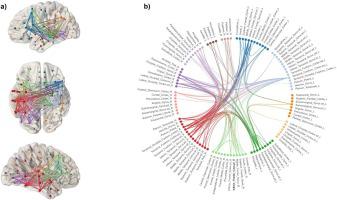NeuroImage: Clinical ( IF 3.4 ) Pub Date : 2020-05-26 , DOI: 10.1016/j.nicl.2020.102297 Liam J Nestor 1 , John Suckling 2 , Karen D Ersche 3 , Anna Murphy 4 , John McGonigle 5 , Csaba Orban 5 , Louise M Paterson 5 , Laurence Reed 5 , Eleanor Taylor 4 , Remy Flechais 5 , Dana Smith 3 , Edward T Bullmore 2 , Rebecca Elliott 4 , Bill Deakin 4 , Ilan Rabiner 6 , Anne-Lingford Hughes 5 , Barbara J Sahakian 2 , Trevor W Robbins 3 , David J Nutt 5 ,

|
The prevalent spatial distribution of abnormalities reported in cognitive fMRI studies in addiction suggests there are extensive disruptions across whole brain networks. Studies using resting state have reported disruptions in network connectivity in addiction, but these studies have not revealed characteristics of network functioning during critical psychological processes that are disrupted in addiction populations. Analytic methods that can capture key features of whole brain networks during psychological processes may be more sensitive in revealing additional and widespread neural disturbances in addiction, that are the provisions for relapse risk, and targets for medication development. The current study compared a substance addiction (ADD; n = 83) group in extended abstinence with a control (CON; n = 68) group on functional MRI (voxel-wise activation) and global network (connectivity) measures related to reward anticipation on a monetary incentive delay task. In the absence of group differences on MID performance, the ADD group showed reduced activation predominantly across temporal and visual regions, but not across the striatum. The ADD group also showed disruptions in global network connectivity (lower clustering coefficient and higher characteristic path length), and significantly less connectivity across a sub-network comprising frontal, temporal, limbic and striatal nodes. These results show that an addiction group in extended abstinence exhibit localised disruptions in brain activation, but more extensive disturbances in functional connectivity across whole brain networks. We propose that measures of global network functioning may be more sensitive in highlighting latent and more widespread neural disruptions during critical psychological processes in addiction and other psychiatric disorders.
中文翻译:

戒瘾人群在奖励预期过程中整个大脑网络受到干扰。
成瘾认知功能磁共振成像研究中报告的异常的普遍空间分布表明,整个大脑网络存在广泛的破坏。使用静息状态的研究报告了成瘾者网络连接的中断,但这些研究尚未揭示成瘾人群在关键心理过程中受到干扰的网络功能特征。能够捕获心理过程中全脑网络关键特征的分析方法可能在揭示成瘾中额外和广泛的神经紊乱方面更敏感,这些神经紊乱是复发风险的规定和药物开发的目标。目前的研究比较了长期禁欲的物质成瘾组(ADD;n = 83)与对照组(CON;n = 68)的功能性 MRI(体素激活)和与奖励预期相关的全局网络(连接性)测量。货币激励延迟任务。在 MID 表现不存在组间差异的情况下,ADD 组主要表现出颞区和视觉区域的激活减少,但纹状体的激活并未减少。 ADD 组还显示出全局网络连接性的破坏(较低的聚类系数和较高的特征路径长度),并且由额叶、颞叶、边缘和纹状体节点组成的子网络的连接性显着减少。这些结果表明,长期戒酒的成瘾组表现出大脑激活的局部破坏,但整个大脑网络的功能连接出现更广泛的干扰。 我们认为,全球网络功能的测量可能更敏感地强调成瘾和其他精神疾病的关键心理过程中潜在的和更广泛的神经破坏。









































 京公网安备 11010802027423号
京公网安备 11010802027423号